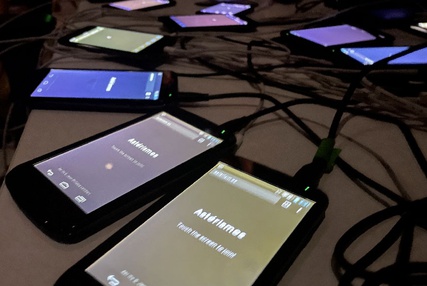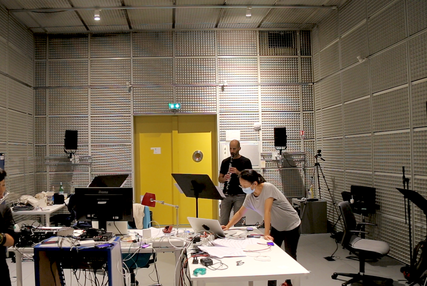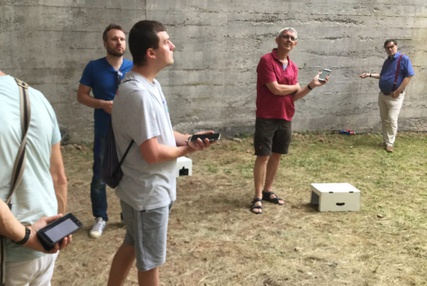Le vendredi 25 mars, dans le cadre des Ateliers du Forum de l’Ircam, Aki Ito et Jean-Philippe Lambert ont fait une démonstration de leur projet « Astérismes », et expérimenté, sur le petit public réuni à cette occasion, une idée pour enrichir l’expérience de leur dispositif de diffusion sonore distribuée…
Petit rappel : ISMM signifie « Interaction son musique mouvement ». S’inscrivant dans la continuité des recherches de l’équipe ISMM, le projet « Astérismes », porté par Aki Ito et Jean-Philippe Lambert, comprend donc dès l’origine un volet « interaction ». L’objectif est bien évidemment avant tout d’impliquer le public dans le discours musical, mais aussi de susciter une écoute active et de connecter les gens, à la fois à la musique et entre eux. Lorsqu’ils se lancent dans leurs recherches, Ito et Lambert s’aperçoivent toutefois que ce principe d’interaction est plus facile à imaginer qu’à réaliser :
« Nous avions déjà pas mal d’expérience sur les interactions “classiques” (pour un utilisateur, ou même plusieurs utilisateurs dans le cadre d’une installation interactive), mais le cadre spécifique d’un concert distribué participatif rebat les cartes. »
Le duo se lance donc, dès qu’il en a l’occasion, dans des expérimentations tous azimuts. Par exemple, demander aux spectateurs de se disposer en cercle, pour répartir les sons et les faire « tourner » – un dispositif qui a l’avantage d’être compréhensible et assez ludique, mais qui s’avère impraticable si l’auditoire est trop nombreux. Mais les premiers retours d’expérience les confirment dans leur approche « sociale » du dispositif, et la nécessité de l’adapter à tous les publics.
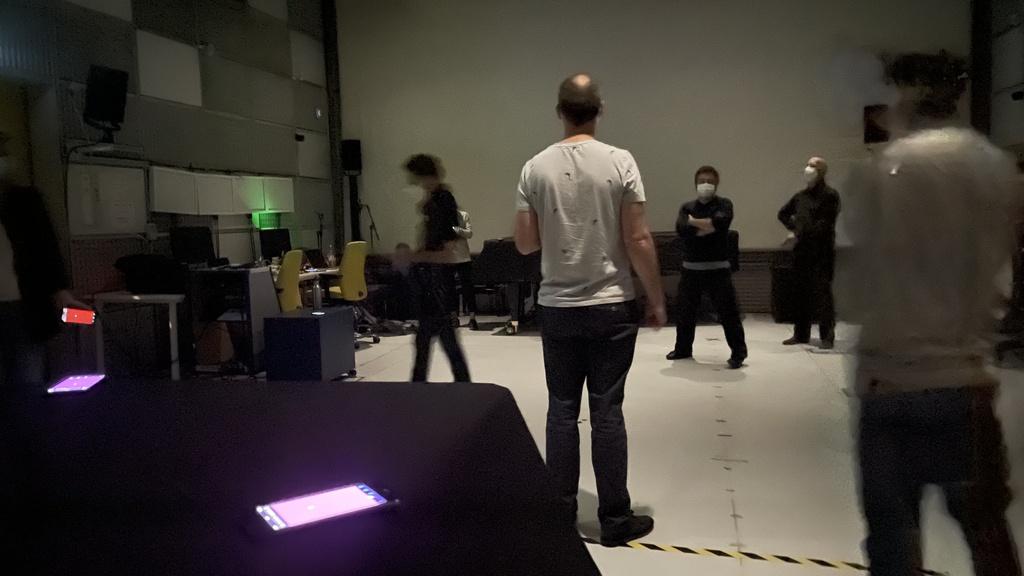 Studio 5
Studio 5
Autre idée, liée à la reconnaissance de gestes des auditeurs via les capteurs de leur smartphone – qui sert déjà, rappelons-le[1] à la diffusion distribuée du son : « Dès lors que le spectateur s’aperçoit qu’il tient véritablement des sons en main, l’idée est de lui donner une forme de contrôle sur ces sons et leurs diffusions, suggèrent Aki et Jean-Philippe : on peut imaginer des petits jeux sonores, voire la possibilité de faire circuler un même son d’un spectateur à un autre grâce à un geste spécifique, qui doit toutefois être à la fois clair et intuitif. »
Un premier problème réside en la bonne volonté du spectateur lui-même : « Nous nous sommes aperçus que, parfois, certaines personnes ne veulent pas participer, ou sont rétives à certains mouvements, ou ne s’aperçoivent pas de l’effet de leurs gestes. »
C’est valable pour tous les projets dans lesquels intervient une part d’interaction : les gens mettent du temps à s’en apercevoir, à comprendre les interactions et à se les approprier. « De manière générale, les plus jeunes ont plus de facilité à s’emparer de l’outil : au lieu d’essayer de comprendre, ils y vont à l’instinct, s’amusent avec, remarquent Aki et Jean-Philippe. »
Faut-il dès lors donner des instructions, ou du moins des suggestions ? Si oui comment ? Des messages qui s’affichent sur l’écran risqueraient par exemple de phagocyter l’attention. Il faut aussi bien doser la nature et l’amplitude du geste : il doit être simple, pour inclure tout le monde, cohérent par rapport au discours musical, et dynamique sans trop – car on n’est pas habitués à faire de grands gestes avec nos gros smartphones ! À l’inverse, une « trop bonne » volonté peut aussi être problématique, car l’aspect ludique pourrait prendre le pas, au détriment de l’attention accordée au musical. C’est le risque du gadget. Un équilibre est à trouver.
Ce vendredi 25 mars, c’est un geste de « partage » d’un son par un membre du public au reste de l’assistance qui est testé (par un geste du bras, le son diffusé sur le portable du premier se « répand » sur les portables des autres, ou d’une partie des autres) – avec des résultats parfois surprenants, dont le plus précieux est sans doute, là encore, le lien social qu’il instaure entre les différents auditeurs impliqués, qui ne se connaissent ni d’Ève ni d’Adam…
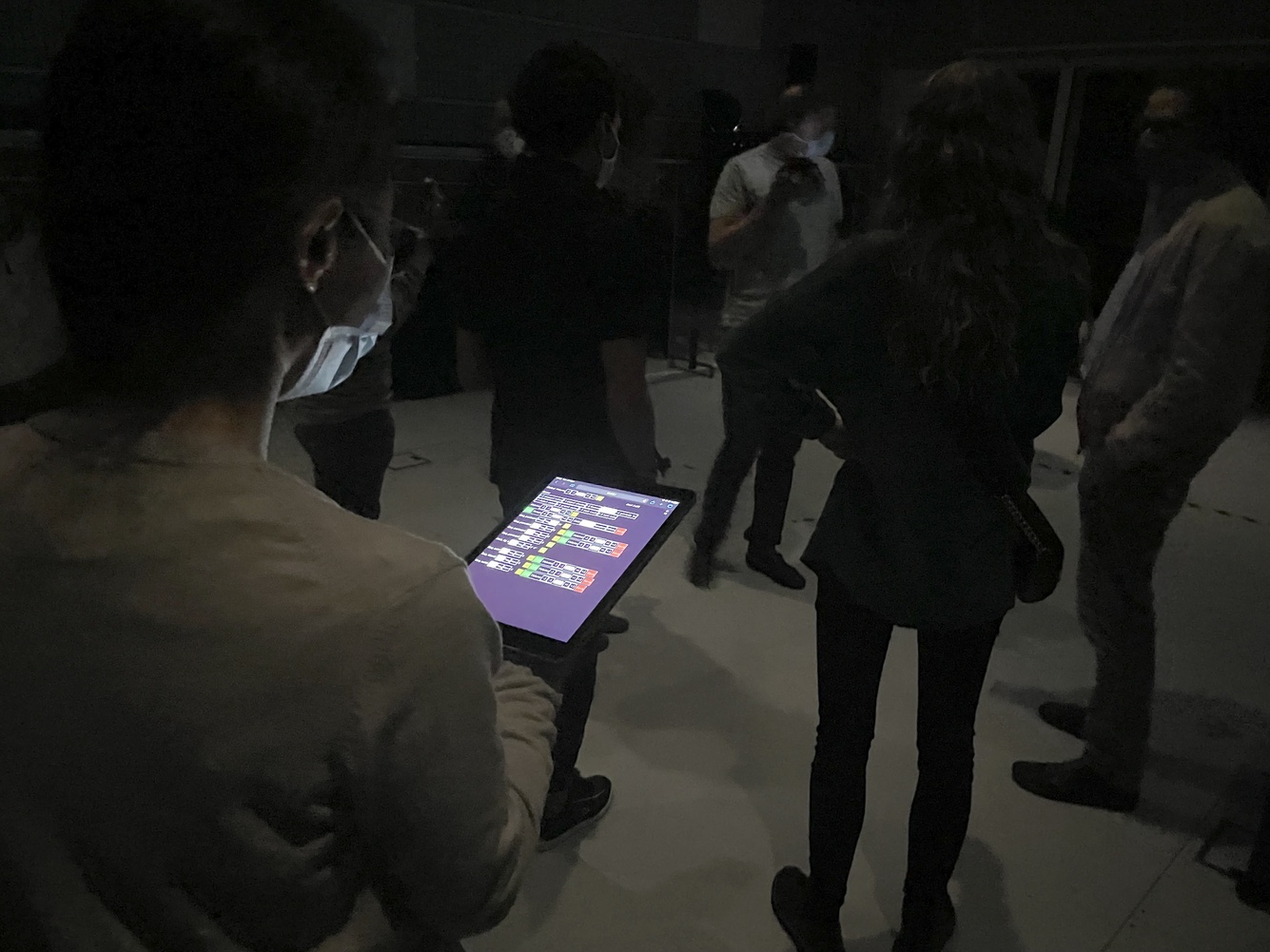 Démonstration d'Astérismes Studio 5 @ Ircam
Démonstration d'Astérismes Studio 5 @ Ircam
« Nous nous sommes dit alors que, puisque le son est diffusé de manière distribuée, peut-être faut-il également penser les interactions de manière distribuée. » D’où un deuxième essai, quelques jours plus tard, au cours duquel tous les membres du public peuvent « prendre » un son et le partager, puis le récupérer, et ainsi de suite.
« Techniquement et socialement, ça marche, dit Jean-Philippe Lambert, mais le phénomène reste assez peu clair pour l’auditeur. Il faudrait peut-être plutôt penser en termes de groupes : tous les membres d’un groupe pourraient manipuler des sons d’une même famille, avec quelques variations minimes au sein d’une famille, et pourraient se reconnaître comme appartenant à ce groupe au sein de l’ensemble. Ce genre d’applications a sans doute du potentiel, mais cela exigerait énormément de développement technique et musical. Cela nous entraînerait très loin, et nous ne sommes pas certains que cela soit une bonne idée dans le cadre de notre projet, où l’on veut surtout privilégier l’écoute. »
« Peut-être que les pistes les plus intéressantes sont davantage en lien avec ma pensée compositionnelle, dit Aki Ito. Je travaille sur des modules musicaux qui cohabitent au sein d’une même pièce, et mon idée est à présent d’organiser les interactions autour de ces modules, de leur orchestration et de leur spatialisation. »

Dans le prochain et dernier épisode de cette série, nous verrons justement comment les contraintes techniques propres du dispositif nourrissent l’imaginaire de la compositrice – et vice versa.



 Studio 5
Studio 5 Démonstration d'Astérismes Studio 5 @ Ircam
Démonstration d'Astérismes Studio 5 @ Ircam